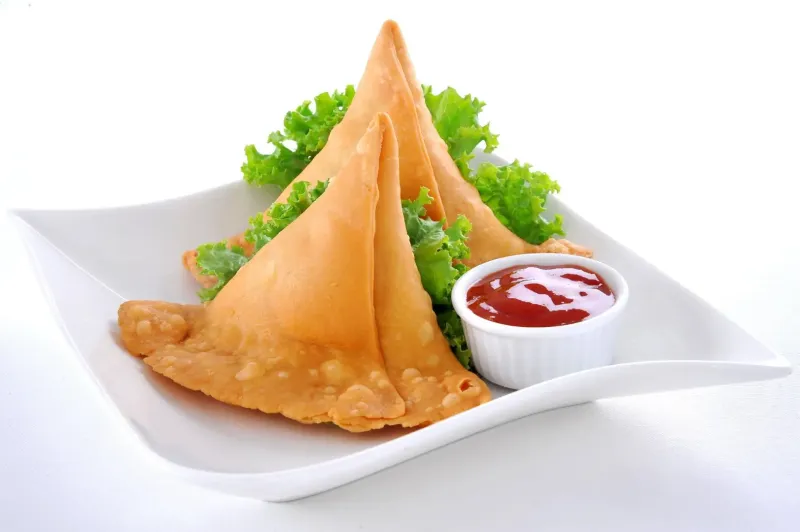
Unraveling the Secrets of the Perfect Samosa
Indian samosas are a popular and delicious snack enjoyed by people all over the world. These deep-fried pastries are filled with a savory mixture of potatoes, peas, and spices, making them a flavorful treat.
One of the key components of a samosa is the dough or pastry used to encase the filling. The dough is typically made from all-purpose flour, water, oil or ghee (clarified butter), and a pinch of salt. This combination results in a crispy and flaky texture that perfectly complements the spicy filling.
To prepare the samosa dough, you start by mixing the flour and salt together in a bowl. Then, you gradually add water while kneading until a smooth and pliable dough is formed. Adding oil or ghee to the dough helps to enhance its flavor and make it more elastic.
Once the dough is ready, it needs to be rested for about 20-30 minutes to allow gluten development and improve its elasticity. This resting period also helps in achieving better results while rolling out the dough later on.
After resting, the dough is divided into small portions which are then rolled out into thin circles or discs using a rolling pin. These circles serve as the base for each individual samosa.
The samosa pastry plays an essential role in ensuring that each bite of this delectable snack offers a delightful combination of textures - crisp on the outside while remaining soft on the inside.
In summary, when it comes to making Indian samosas, attention must be given not only to creating a flavorful filling but also to preparing an excellent samosa pastry or dough that gives this iconic snack its characteristic taste and texture.
Ingredients:
- 2 cups all-purpose flour
- 1/4 cup vegetable oil
- 1 teaspoon salt
- 1 cup water
Filling:
- 2 medium potatoes, boiled and mashed
- 1/2 cup peas
- 1 small onion, finely chopped
- 2 cloves garlic, minced
- 1 teaspoon ginger, grated
- 1 teaspoon cumin seeds
- 1 teaspoon garam masala
- Salt to taste
- Vegetable oil for frying
Instructions:
1. In a mixing bowl, combine flour, vegetable oil, salt, and water. Knead into a smooth dough. Set aside.
2. Heat some oil in a pan and add cumin seeds. Once they splutter, add onions, garlic, and ginger. Sauté until onions turn translucent.
3. Add peas and cook for a couple of minutes. Then add mashed potatoes, garam masala, and salt. Mix well until everything is combined.
4. Divide the dough into small balls and roll each ball into a thin circle.
5. Cut the circle in half and fold each half into a cone shape.
6. Fill the cones with the potato mixture and seal the edges using water to form triangle-shaped samosas.
7. Heat oil in a deep pan or fryer over medium heat.
8. Fry the samosas until golden brown on both sides.
9. Remove from heat and drain excess oil on paper towels.
10. Serve hot with chutney
Tips for achieving a crispy and golden crust for your vegetarian samosas
When it comes to vegetarian samosas, achieving a crispy and golden crust is essential for a delightful eating experience. The crispy crust adds texture and enhances the overall taste of these savory pastries. In this section, we will explore some tips and cooking techniques to help you achieve that perfect crispy and golden crust for your vegetarian samosas.
One of the key factors in achieving a crispy crust is the dough. Using a combination of all-purpose flour and semolina can result in a lighter and crisper texture. Additionally, adding a pinch of baking powder to the dough can help create air pockets, resulting in a flakier crust.
Another important aspect is frying technique. Deep frying the samosas in hot oil at the right temperature is crucial. Make sure the oil is heated to around 350°F (175°C) before adding the samosas. This high heat will quickly seal the outer layer, creating that desirable crunchiness.
To ensure an evenly cooked crust, it's advisable to fry samosas in small batches rather than overcrowding the pan. This allows each samosa to have enough space for proper circulation of heat, resulting in an evenly golden-brown exterior.
Lastly, draining excess oil after frying plays a significant role in maintaining crispiness. Place fried samosas on paper towels or a wire rack to remove any excess oil before serving them.
By following these tips and cooking techniques, you can achieve that perfect crispy and golden crust for your vegetarian samosas - making them irresistible appetizers or snacks for any occasion!








Showing 0 verified guest comments